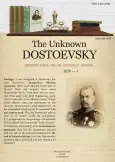“Nero (artist)” in F. M. Dostoevsky’s workbook of 1864–1867
- Autores: Smirnova E.L.1
-
Afiliações:
- Petrozavodsk State University
- Edição: Volume 7, Nº 1 (2020)
- Páginas: 118-132
- Seção: Articles
- URL: https://journal-vniispk.ru/2409-5788/article/view/285315
- DOI: https://doi.org/10.15393/j10.art.2020.4441
- ID: 285315
Citar
Texto integral
Resumo
The article examines the problem of attribution of an essay from F. M. Dostoevsky’s workbook of 1864–1867 (Russian State Archive of Literature and Art. Fund 212.1.5. p. 10), titled “The Usurer”. The novelty of the study is in that Nero (the artist), a character who emerged from the writer’s knowledge and concept of Emperor Nero, for the first time becomes the subject of detailed analysis. Based on the evidence from the classical and early Christian writers, as well as on scientific and literary works written during Dostoevsky’s lifetime, the author makes an argument for Nero’s figure to be considered a junction of at least three elements. He is not merely Nero-the-artist, but also Nero-the-persecutor of Christians and Nero-the Antichrist. This image reveals a ramified network of extensive ties with the preparatory materials for an early draft of “The Idiot”. Thus, it augments the aggregate of B. N. Tikhomirov’s arguments regarding other records, characters, motifs and prototypes in this essay. It also support his theory regarding “The Usurer”, which states that it is not the author’s independent and unexecuted idea, but, rather, should be examined in the framework of the creative history of “The Idiot”, specifically, its initial stage.
Palavras-chave
Sobre autores
Ekaterina Smirnova
Petrozavodsk State University
Autor responsável pela correspondência
Email: esmirnova@petrsu.ru
PhD in History, Associate Professor of the Department of Foreign History, Political Science and International Relations, Institute of History, Political and Social Sciences
Rússia, pr. Lenina 33, Petrozavodsk, Republic of Karelia, 185910Bibliografia
- Barsht K. A. Graphics in Draft Copies by F. M. Dostoevsky and Verbal-Graphic Forms of Art. In: Russkaya literatura i zarubezhnoe iskusstvo [Russian Literature and Foreign Art]. Leningrad, Nauka Publ., 1986, pp. 306–316. (In Russ.)
- Barsht K. A. The Languages of the Original Manuscript of F. M. Dostoevsky. In: Yazyki rukopisey [Manuscript Languages]. St. Petersburg, 2000, pp. 122–146. (In Russ.)
- Barsht K. A. The Сalligraphy of Fedor Dostoevsky in His Manuscripts to the Novel “Crime and Punishment”. In: Neizvestnyy Dostoevskiy [The Unknown Dostoevsky], 2018, no. 3, pp. 3–45. Available at: http://unknown-dostoevsky.ru/files/redaktor_pdf/1540979428.pdf (accessed on January 09, 2020). doi: 10.15393/j10.art.2018.3641 (In Russ.)
- Biblioteka F. M. Dostoevskogo: opyt rekonstruktsii, nauchnoe opisanie [F. M. Dostoevsky’s Library: The Experiment of Reconstruction, Scientific Description]. St. Petersburg, Nauka Publ., 2005. 338 p. (In Russ.)
- Bokova V. M. The Restless Spirit of the Times. Social Thought of the First Third of the 19th Century. In: Ocherki russkoy kul’tury XIX veka: v 6 tomakh [Essays on Russian Culture of the 19th Century: in 6 Vols]. Moscow, Moscow State University Publ., 2003, vol. 4, pp. 17–152. (In Russ.)
- Volynskiy A. L. Dostoevsky. St. Petersburg, Energiya Publ., 1906. 501 p. (In Russ.)
- Derevenskiy B. G. Kniga ob Antikhriste [Book of the Antichrist]. St. Petersburg, Amfora Publ., 2007. 653 p. (In Russ.)
- Derevenskiy B. G. Iisus Khristos v dokumentakh istorii [Jesus Christ in the Documents of History]. St. Petersburg, Aleteyya Publ., 2017. 577 p. (In Russ.)
- Dostoevskiy F. M. Polnoe sobranie sochineniy: v 30 tomakh [The Complete Works: in 30 Vols]. Leningrad, Nauka Publ., 1972–1990. (In Russ.)
- Zagidullina M. V. The Usurer. In: Dostoevskiy: sochineniya, pis’ma, dokumenty: slovar’spravochnik [Dostoevsky: Works, Letters, Documents: Dictionary–Reference Book]. St. Petersburg, Pushkinskiy Dom Publ., 2008, pp. 333–334. (In Russ.)
- Zakharov V. N. Imya avtora — Dostoevskiy. Ocherk tvorchestva [The Author’s Name Is Dostoevsky. An Essay on Creative Works]. Moscow, Indrik Publ., 2013. 456 p. (In Russ.)
- Kamenev E. V. Kategorii mirovozzreniya russkogo ofitserstva epokhi napoleonovskikh voyn [Worldview Categories of Russian Officers During the Napoleonic Wars]. Petrozavodsk, Petrozavodsk State University Publ., 2017. 67 p. Available at: http://elibrary.karelia.ru/docs/kamenev/kateg_mirovozzr_russk_oficerstv_epohi_napol_voin/total.pdf (accessed on January 09, 2020). (In Russ.)
- Knabe G. S. Nero and Neronism. In: Knabe G. S. Izbrannye trudy. Teoriya i istoriya kul’tury [Knabe G. S. Selected Works. Theory and History of Culture]. Moscow, St. Petersburg, Letniy sad Publ., ROSSPEN Publ., 2006, pp. 500–514. (In Russ.)
- Maskevich E. D., Tikhomirov B. N. The Teen Years of Mikhail and Fedor Dostoevsky (New Archival Materials of 1837–1839). In: Neizvestnyy Dostoevskiy [The Unknown Dostoevsky], 2019, no. 2, pp. 56–93. Available at: http://unknown-dostoevsky.ru/files/redaktor_pdf/1562749532.pdf (accessed on January 09, 2020). doi: 10.15393/j10.art.2019.3981 (In Russ.)
- Men’ A. Bibliologicheskiy slovar’: v 3 tomakh [Bibliological Dictionary: in 3 Vols]. Moscow, A. Men’s Fund Publ., 2002, vol. 1. 605 p. (In Russ.)
- Tikhomirov B. N. Religioznye aspekty tvorchestva F. M. Dostoevskogo. Problemy interpretatsii, kommentirovaniya, tekstologii: dis. … d-ra filol. nauk [Religious Aspects of the Work of F. M. Dostoevsky. Problems of Interpretation, Commenting, Textology. PhD philol. sci. diss.]. St. Petersburg, 2006. 567 p. (In Russ.)
- Tikhomirov B. N. Challenges in Publishing the Notebooks and Copybooks of F. M. Dostoevsky. In: Vestnik Rossiyskogo gumanitarnogo nauchnogo fonda [Bulletin of the Russian Foundation for Humanities], 2010, no. 1 (58), pp. 101–115. (In Russ.)
- Tikhomirov B. N. Did Dostoevsky Have an Unrealized Intension Known as “The Usurer”? In: Neizvestnyy Dostoevskiy [The Unknown Dostoevsky], 2017, no. 3, pp. 3–15. Available at: http://unknown-dostoevsky.ru/files/redaktor_pdf/1508167445.pdf (accessed on January 09, 2020). doi: 10.15393/j10.art.2017.3241 (In Russ.)
Arquivos suplementares










